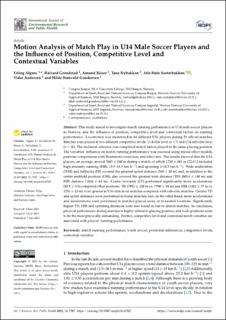| dc.contributor.author | Algrøy, Erling Andre | |
| dc.contributor.author | Grendstad, Halvard | |
| dc.contributor.author | Riiser, Amund | |
| dc.contributor.author | Nybakken, Tone | |
| dc.contributor.author | Sæterbakken, Atle Hole | |
| dc.contributor.author | Andersen, Vidar | |
| dc.contributor.author | Gundersen, Hilde Stokvold | |
| dc.date.accessioned | 2021-08-31T10:53:00Z | |
| dc.date.available | 2021-08-31T10:53:00Z | |
| dc.date.created | 2021-07-27T13:13:25Z | |
| dc.date.issued | 2021 | |
| dc.identifier.citation | Algroy, E., Grendstad, H., Riiser, A., Nybakken, T., Saeterbakken, A. H., Andersen, V., & Gundersen, H. S. (2021). Motion analysis of match play in U14 male soccer players and the influence of position, competitive level and contextual variables. International Journal of Environmental Research and Public Health, 18(14). | en_US |
| dc.identifier.issn | 1661-7827 | |
| dc.identifier.uri | https://hdl.handle.net/11250/2771921 | |
| dc.description.abstract | This study aimed to investigate match running performance in U14 male soccer players in Norway, and the influence of position, competitive level and contextual factors on running performance. Locomotion was monitored in 64 different U14 players during 23 official matches. Matches were played at two different competitive levels: U14 elite level (n = 7) and U14 sub-elite level (n = 16). The inclusion criterion was completed match halves played in the same playing position. The variables’ influence on match running performance was assessed using mixed-effect models, pairwise comparisons with Bonferroni correction, and effect size. The results showed that the U14 players, on average, moved 7645 ± 840 m during a match, of which 1730 ± 681 m (22.6%) included high-intensity running (HIR, 13.5–18.5 km·h−1) and sprinting (>18.5 km·h−1). Wide midfielders (WM) and fullbacks (FB) covered the greatest sprint distance (569 ± 40 m) and, in addition to the centre midfield position (CM), also covered the greatest total distance (TD) (8014 ± 140 m) and HIR distance (1446 ± 64 m). Centre forwards (CF) performed significantly more accelerations (49.5 ± 3.8) compared other positions. TD (7952 ± 120 m vs. 7590 ± 94 m) and HIR (1432 ± 57 m vs. 1236 ± 43 m) were greater in U14 elite-level matches compared with sub-elite matches. Greater TD and sprint distances were performed in home matches, but, on the other hand, more accelerations and decelerations were performed in matches played away or in neutral locations. Significantly higher TD, HIR and sprinting distances were also found in lost or drawn matches. In conclusion, physical performance during matches is highly related to playing position, and wide positions seem to be the most physically demanding. Further, competitive level and contextual match variables are associated with players’ running performance. | en_US |
| dc.language.iso | eng | en_US |
| dc.publisher | MDPI | en_US |
| dc.rights | Navngivelse 4.0 Internasjonal | * |
| dc.rights.uri | http://creativecommons.org/licenses/by/4.0/deed.no | * |
| dc.subject | match running performance | en_US |
| dc.subject | youth soccer | en_US |
| dc.subject | positional differences | en_US |
| dc.subject | competitive levels | en_US |
| dc.subject | contextual variables | en_US |
| dc.title | Motion analysis of match play in u14 male soccer players and the influence of position, competitive level and contextual variables | en_US |
| dc.type | Peer reviewed | en_US |
| dc.type | Journal article | en_US |
| dc.description.version | publishedVersion | en_US |
| dc.rights.holder | © 2021 by the authors | en_US |
| dc.source.pagenumber | 9 | en_US |
| dc.source.volume | 18 | en_US |
| dc.source.journal | International Journal of Environmental Research and Public Health (IJERPH) | en_US |
| dc.source.issue | 14 | en_US |
| dc.identifier.doi | 10.3390/ijerph18147287 | |
| dc.identifier.cristin | 1922777 | |
| cristin.ispublished | true | |
| cristin.fulltext | original | |
| cristin.qualitycode | 1 | |

